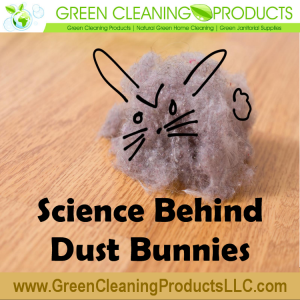Green cleaning is the rave. Whether you use traditional toxic cleaners or new safer ones, key to being healthy and green is to clean. If you do not, dust bunnies form and accumulate.
Dust bunnies, also called dust mice, are not an animal, but rather a term used to describe the small clumps of dust and debris that form under furniture and in the corners that are not cleaned regularly. They are inanimate and made of hair, lint, dead skin, spider webs, dust, and sometimes light rubbish and debris. They can house dust mites and can lower the efficiency of dust filters resulting from clogging. Dust bunnies are often held together by static electricity that becomes a felt-like entanglement.
Science of Dust Bunnies
As summarized by Lorin Matthews, assistant professor of physics at Baylor University, “The forces that hold the dust bunnies together can be the entangled fibers themselves. They get matted, much like lint or felt. You can also have electrostatic forces between the dust particles that help hold the dust bunnies together.” (Lorin Matthews was coauthor of “Formation of Cosmic Dust Bunnies,” an article published in 2007 in the IEEE Transactions on Plasma Science.)
The movement of a single large particle can start the formation of a dust bunny. Small particles of hair, fibers, food and other items are blown into each other by the current created from the heating and cooling system or even from opening a door, walking through the house, or having an open window. All of this action causes friction that will enable the particles to hold onto each other and become an entangled web and that gets larger as it moves along and picks up more debris. Some items, such as food particles, may have an oily surface that helps to also hold it all together as it grows.
Dust bunnies often are found under low, heavy furniture. The physical height of the furniture makes it difficult to see under them, thereby obscuring what the floor looks like under it; and making it hard to clean under them as well. The weight makes it challenging to move such furnishings, so only the most dedicated cleaners will shift the them to sweep, mop, or vacuum underneath, and even then, the furniture may rarely be moved.
MythBuster of Dust Bunnies
Although they appear harmless, they may not be. Dust bunnies can contain allergens, including dust mites. It has also been found that household dust absorbs toxic chemicals and other hazardous substances, thus negatively impacting our health. They are also harmful to electronics, as they can obstruct air flow through heat sinks, raising temperatures significantly, and therefore shortening the life of electronic components.
Knowing about dust bunnies does not help if you do not know what to do about them. Although there are many tools available to assist with the task of dusting, the Fluffy Microfiber Duster by Cleans Green™ integrates the latest in technology with the split microfiber filaments, as well as the most desired design features collected by the feedback obtained from multiple focus groups. (Available on Amazon at www.BestDuster.com or http://www.amazon.com/Microfiber-Bendable-Flexible-Washable-Extendable/dp/B00A3CQSKG/ in lime green and http://www.amazon.com/Duster-Microfiber-Extendable-Extension-Replacement/dp/B00KD6J0RU/ in royal blue.) Additionally Green Cleaning Products LLC has provided 15 How to Dust Tips and Tricks for you.
Leave a Reply